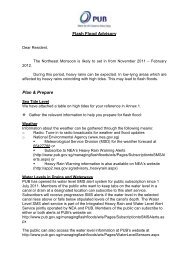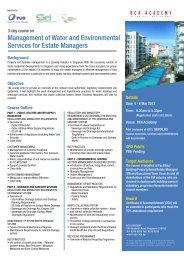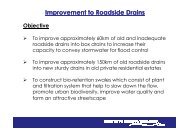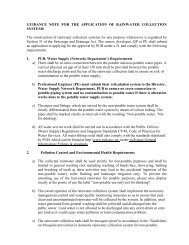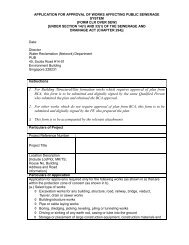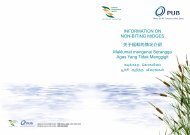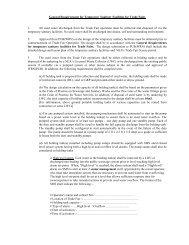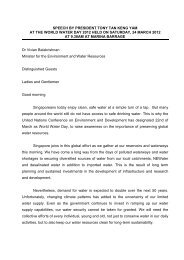Inspection, cleaning and sterilisation of water storage tanks - PUB
Inspection, cleaning and sterilisation of water storage tanks - PUB
Inspection, cleaning and sterilisation of water storage tanks - PUB
You also want an ePaper? Increase the reach of your titles
YUMPU automatically turns print PDFs into web optimized ePapers that Google loves.
<strong>Inspection</strong>, <strong>cleaning</strong> <strong>and</strong> <strong>sterilisation</strong> <strong>of</strong> <strong>water</strong> <strong>storage</strong> <strong>tanks</strong><br />
A <strong>Inspection</strong> <strong>and</strong> <strong>cleaning</strong> procedures<br />
1 The inspection <strong>and</strong> <strong>cleaning</strong> <strong>of</strong> <strong>water</strong> <strong>storage</strong> <strong>tanks</strong> shall be undertaken by a licensed<br />
<strong>water</strong> service plumber.<br />
2 Before the commencement <strong>of</strong> any <strong>cleaning</strong> <strong>and</strong> <strong>sterilisation</strong> work, the licensed <strong>water</strong><br />
service plumber shall notify the Authority on prescribed forms <strong>of</strong> the work to be<br />
carried out.<br />
3 Before the commencement <strong>of</strong> any <strong>cleaning</strong> <strong>and</strong> <strong>sterilisation</strong> work, a joint inspection<br />
with the owner or his representative shall be carried out to check on the condition <strong>of</strong><br />
the <strong>water</strong> <strong>storage</strong> tank (including its associated fittings such as the overflow pipes,<br />
air vents, nettings, tank manhole covers, etc <strong>and</strong> ancillary equipment).<br />
4 Before the commencement <strong>of</strong> any inspection or <strong>cleaning</strong> <strong>and</strong> <strong>sterilisation</strong> work on<br />
the <strong>water</strong> <strong>storage</strong> tank, the owner or his authorised representative shall turn <strong>of</strong>f<br />
power supply to the <strong>water</strong> tank. The licensed <strong>water</strong> service plumber shall place a<br />
logout/tag out card at the switch board after the power supply to the tank has been<br />
switched <strong>of</strong>f. The licensed <strong>water</strong> service plumber shall use a contactless voltage<br />
meter to test the exposed areas on the <strong>water</strong> tank to confirm that it is safe to inspect<br />
<strong>and</strong> work on <strong>and</strong> in the tank before he proceeds with his inspection/work. All<br />
persons involved in the inspection <strong>and</strong> <strong>cleaning</strong> <strong>and</strong> <strong>sterilisation</strong> work shall use<br />
proper rubber gloves <strong>and</strong> safety shoes. On completion <strong>of</strong> inspection <strong>and</strong> <strong>cleaning</strong><br />
<strong>and</strong> <strong>sterilisation</strong> work, the licensed <strong>water</strong> service plumber shall remove the log<br />
out/tag out card at the switch board <strong>and</strong> the owner or his authorised representative<br />
shall then turn on power supply to the <strong>water</strong> tank. The licensed <strong>water</strong> service<br />
plumber shall use a contactless voltage meter to again test the exposed areas on the<br />
<strong>water</strong> tank to confirm that it is safe electrically.<br />
5 Water <strong>storage</strong> <strong>tanks</strong> which are equipped with <strong>water</strong> level sensing devices with<br />
control circuits that regulate the <strong>water</strong> level inside the <strong>tanks</strong> <strong>and</strong> activate / deactivate<br />
the electric <strong>water</strong> pump(s) shall use extra low voltage (e.g. d.c. voltage source at 36<br />
volts or a.c. voltage source at 24 volts) for the <strong>water</strong> level control circuits. Power<br />
supply to the <strong>water</strong> level sensing devices shall be independent <strong>of</strong> each other, i.e. the<br />
power supply to any one individual <strong>water</strong> level sensing device must be able to be<br />
shut <strong>of</strong>f without affecting the power supply to the other <strong>water</strong> level sensing devices.<br />
6 All remedial works to the tank <strong>and</strong> its associated fittings <strong>and</strong> ancillary equipment<br />
arising from the joint inspection shall be carried out before commencement <strong>of</strong><br />
<strong>cleaning</strong> work. Before the commencement <strong>of</strong> any <strong>cleaning</strong> <strong>and</strong> <strong>sterilisation</strong> work,<br />
adequate notice should be given to consumers <strong>and</strong> adequate signboards shall be<br />
displayed to indicate that the <strong>water</strong> <strong>tanks</strong> are undergoing <strong>cleaning</strong> <strong>and</strong> <strong>sterilisation</strong>.<br />
7 The <strong>water</strong> in the tank shall be used to around 150 to 200 mm above the bottom <strong>of</strong><br />
the tank before the tank is isolated <strong>and</strong> the outlet pipes shut <strong>of</strong>f.<br />
8 The external <strong>of</strong> the tank <strong>and</strong> the tank manhole covers shall be cleaned before the<br />
tank covers are opened.
9 All tank manhole covers shall be opened to admit light <strong>and</strong> for ventilation <strong>and</strong><br />
access. It shall be ensured that the tank is isolated <strong>and</strong> all outlet pipes are shut.<br />
10 All statutory safety requirements as well as other necessary <strong>and</strong> relevant safety<br />
measures shall be complied with at all times to ensure that it is safe to enter the tank.<br />
11 All workers involved in the <strong>cleaning</strong> work must be certified by a medical doctor to<br />
be free from <strong>water</strong>borne diseases.<br />
12 All workers involved in the <strong>cleaning</strong> work shall wash, clean <strong>and</strong> disinfect<br />
themselves thoroughly before entering the tank.<br />
13 All workers involved in the <strong>cleaning</strong> work must observe safety measures at all times<br />
<strong>and</strong> mush be properly equipped with the necessary safety equipment <strong>and</strong> gear.<br />
14 Equipment <strong>and</strong> tools used shall not have sharp edges that may damage the inside <strong>of</strong><br />
the tank. The equipment <strong>and</strong> tills shall be exclusively used for the <strong>cleaning</strong> <strong>of</strong><br />
potable <strong>water</strong> <strong>tanks</strong> only <strong>and</strong> shall be disinfected before every use.<br />
15 To prevent sludge <strong>and</strong> sediments from entering the outlet pipes, all outlets <strong>of</strong> these<br />
pipes shall be covered. The sludge <strong>and</strong> sediments shall be placed in containers for<br />
disposal at authorised dumping grounds.<br />
16 The internal <strong>of</strong> the tank including the floors, walls, ro<strong>of</strong>, internal <strong>of</strong> the tank manhole<br />
covers, etc shall then be cleaned using appropriate methods such as scrubbing,<br />
pressure jet, etc, Sediments <strong>and</strong> solids shall be collected in containers for disposal at<br />
authorised dumping grounds.<br />
17 The ro<strong>of</strong> <strong>and</strong> sides <strong>of</strong> the tank walls above the overflow level shall be cleaned <strong>and</strong><br />
disinfected too. Chlorine solution <strong>of</strong> 200 mg/litre shall be applied onto the internal<br />
surfaces <strong>of</strong> the ro<strong>of</strong> <strong>and</strong> sides <strong>of</strong> the tank walls above the overflow level (by spraying<br />
or brushing) <strong>and</strong> left there for at least 30 minutes after they have been cleaned <strong>and</strong><br />
washed.<br />
18 The entire tank (including the ro<strong>of</strong> <strong>and</strong> sides <strong>of</strong> the tank walls above the overflow<br />
level) shall be thoroughly washed <strong>and</strong> flushed until it is clean <strong>and</strong> free from dirt,<br />
solids, chemicals or other foreign matter which may affect the quality <strong>of</strong> <strong>water</strong><br />
stored <strong>and</strong> supplied to consumers.<br />
B Sterilisation procedure<br />
1 The <strong>sterilisation</strong> <strong>of</strong> <strong>water</strong> <strong>storage</strong> <strong>tanks</strong> shall be undertaken by a licensed <strong>water</strong><br />
service plumber.<br />
2 After <strong>cleaning</strong>, potable <strong>water</strong> is fed into the cleaned tank up to overflow level.<br />
Sterilising chemical in solution form containing chlorine shall be gradually added<br />
while the tank is being filled to ensure thorough mixing. Safety procedure for the
h<strong>and</strong>ling <strong>of</strong> such chemical must be observed at all times. Introduction <strong>of</strong> the<br />
sterilising chemical into the tank in powder form is not allowed.<br />
3 The chemical concentration for <strong>sterilisation</strong> <strong>of</strong> the tank shall be 50 mg/litre <strong>of</strong> free<br />
chlorine (i.e. 50 ppm <strong>of</strong> free chlorine). Ordinary “bleaching powder” in solution<br />
form or sodium form or sodium hypochlorite solution may be used with equivalent<br />
concentration.<br />
4 While the <strong>water</strong> in the tank is being sterilized, all outlet pipes from the tank must be<br />
closed tight <strong>and</strong> no <strong>water</strong> shall be allowed to flow into these pipes as the <strong>water</strong> under<br />
<strong>sterilisation</strong> may not be safe for human consumption.<br />
5 The sterilized <strong>water</strong> shall be kept in the tank for at least 24 hours. The <strong>water</strong> in the<br />
tank is then drained <strong>of</strong>f completely through the wash out pipe <strong>and</strong> the tank refilled<br />
with potable <strong>water</strong> through the inlet pipe. It must be ensured that all outlet pipes are<br />
closed tight before refilling the tank with potable <strong>water</strong>.<br />
6 Water samples shall then be taken from the tank sampling tap for bacteriological <strong>and</strong><br />
chemical analyses at a SACSINGLAS accredited laboratory. In the absence <strong>of</strong> a<br />
tank sampling tap, <strong>water</strong> samples shall be taken from the bottom <strong>of</strong> the tank using an<br />
appropriate sampling device.<br />
7 Water samples shall be taken by a licensed <strong>water</strong> service plumber <strong>and</strong> should be<br />
sealed <strong>and</strong> marked by the owner or his representative <strong>and</strong> escorted to the SAC<br />
SINGLAS accredited laboratory. Alternatively, the <strong>water</strong> samples may be taken by<br />
personnel from the SACSINGLAS accredited laboratory <strong>and</strong> sealed <strong>and</strong> marked by<br />
the owner or his representative. Water samples with broken seals shall be rejected.<br />
8 The tank <strong>and</strong> the <strong>water</strong> shall only be put into use after satisfactory test reports are<br />
obtained form the SACSINGLAS accredited laboratory. All downfeed <strong>and</strong><br />
distributing pipes from the tank shall be thoroughly flushed until clean before <strong>water</strong><br />
from the tank is put into use.<br />
9 If the test reports from the SACSINGLAS accredited laboratory are unsatisfactory,<br />
terilization shall have to be carried out again.<br />
10 After <strong>cleaning</strong> <strong>and</strong> terilization have been completed, a final joint inspection with<br />
the owner or his representative to check on the condition <strong>of</strong> the <strong>water</strong> tank shall be<br />
carried out to ensure that all remedial works have been carried out <strong>and</strong> all tank<br />
openings (such as air vents, overflow <strong>and</strong> warning pipes, etc) have been properly<br />
screened to prevent birds, insects <strong>and</strong> other possible contaminants from entering the<br />
<strong>water</strong> tank.<br />
11 Upon completion <strong>of</strong> <strong>cleaning</strong> <strong>and</strong> terilization work, the licensed <strong>water</strong> service<br />
plumber shall notify the authority on prescribed forms <strong>of</strong> the completion work<br />
accompanied with the laboratory <strong>water</strong> sample test reports within the time period<br />
stipulated by the Authority.
12 Only in cases where the tank cannot be shutdown for 24 hours or more, the<br />
following <strong>sterilisation</strong> procedure may be used:<br />
Observe procedures B1 to B11 but add sufficient chemicals to give the <strong>water</strong><br />
a dose <strong>of</strong> 500 mg/litre <strong>of</strong> free chlorine. Then keep the sterilized <strong>water</strong> in the<br />
tank for at least 2 hours before draining completely.<br />
Following the draining <strong>and</strong> refilling to overflow level, the tank <strong>and</strong> <strong>water</strong> can<br />
be put into use. Onsite testing <strong>of</strong> the chlorine concentration in the <strong>water</strong> in<br />
the tank shall be carried out to ensure that the chlorine concentration is<br />
satisfactory before the tank <strong>and</strong> <strong>water</strong> are put into use. All downfeed <strong>and</strong><br />
distributing pipes from the tank shall be thoroughly flushed until clean<br />
before <strong>water</strong> from the tank is put into use.<br />
Water samples shall be taken at the same time <strong>and</strong> sent to a SACSINGLAS<br />
accredited laboratory for bacteriological <strong>and</strong> chemical analyses. If the test<br />
reports from the SACSINGLAS accredited laboratory are unsatisfactory,<br />
<strong>sterilisation</strong> shall have to be carried out again.<br />
The use <strong>of</strong> any other sterilising chemical other than chlorine for the<br />
<strong>sterilisation</strong> <strong>of</strong> <strong>water</strong> <strong>storage</strong> <strong>tanks</strong> is allowed only if the chemical <strong>and</strong> its<br />
application procedures have been approved by the Authority. Similarly, the<br />
use <strong>of</strong> any other <strong>cleaning</strong> or <strong>sterilisation</strong> procedures is allowed only if the<br />
procedures have been approved by the Authority.



